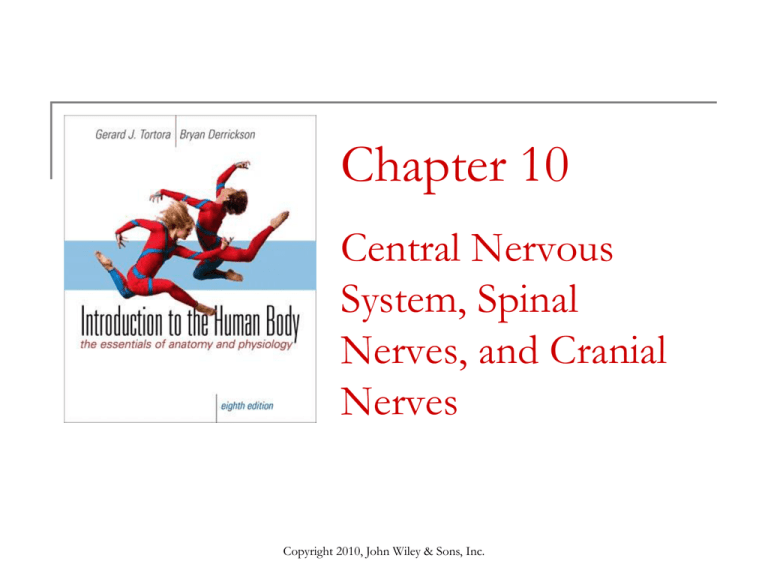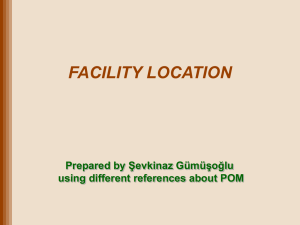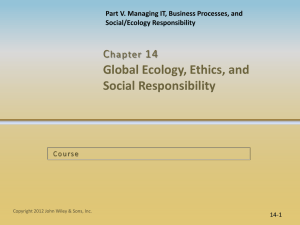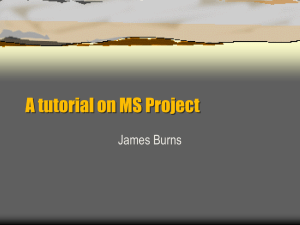
Chapter 10
Central Nervous
System, Spinal
Nerves, and Cranial
Nerves
Copyright 2010, John Wiley & Sons, Inc.
End of Chapter 10
Copyright 2010 John Wiley & Sons, Inc.
All rights reserved. Reproduction or translation of this
work beyond that permitted in section 117 of the 1976
United States Copyright Act without express permission
of the copyright owner is unlawful. Request for further
information should be addressed to the Permission
Department, John Wiley & Sons, Inc. The purchaser may
make back-up copies for his/her own use only and not
for distribution or resale. The Publishers assumes no
responsibility for errors, omissions, or damages caused
by the use of theses programs or from the use of the
information herein.
Copyright 2010, John Wiley & Sons, Inc.
Spinal Cord Structure: Protection and
Coverings
Vertebrae
Spinal meninges
Three layers of connective tissue
Dura mater
Arachnoid mater
Pia mater
Continuous with cranial meninges
Cerebrospinal fluid (CSF)
Copyright 2010, John Wiley & Sons, Inc.
Spinal Meninges and Spaces
Epidural space: between vertebrae and dura
mater
Dura mater- tough ,dense connective tissue
Arachnoid mater: resembles spider’s web
Extends into subarachnoid space
Subarachnoid space
Extends to vertebra S2 (well beyond spinal cord)
CSF circulates in this space
Pia mater: thin, delicate layer
Adheres to surface spinal cord (and brain)
Contains blood vessels
Copyright 2010, John Wiley & Sons, Inc.
Spinal
Meninges
and Spaces
Copyright 2010, John Wiley & Sons, Inc.
Gross Anatomy of Spinal Cord
Extends from medulla of brain to L2 vertebra
Cauda equina (horse’s tail)
Left and right halves partially separated by
Extends inferior to end of spinal cord
Consists of roots of lumbar, sacral and coccygeal
spinal nerves
Anterior median fissure and posterior median
sulcus
Small central canal (filled with CSF) in middle
Enlargements: cervical and lumbar regions
Points of origins of nerves to upper and lower limbs
Copyright 2010, John Wiley & Sons, Inc.
Gross
Anatomy of
Spinal Cord
Copyright 2010, John Wiley & Sons, Inc.
Internal Structure of Spinal Cord
Gray matter forms “H” (or “butterfly”)
Three horns on each side; sites of cell bodies
Posterior gray horns: contain sensory neurons
Anterior gray horns: contain somatic motor neurons
Lateral: contain autonomic motor neurons
White matter (surrounds gray “H”)
Consists of white columns
Posterior, anterior, and lateral columns
Contain tracts (bundles of axons)
Sensory tracts: ascending to brain
Motor tracts: descending from brain
Copyright 2010, John Wiley & Sons, Inc.
Internal Structure of Spinal Cord
Copyright 2010, John Wiley & Sons, Inc.
Spinal Nerves
31 pairs
Named according to level of vertebra
C1-C8, T1-T12, L1-L5, S1-S5, 1 coccygeal
Emerge from spinal cord through intervertebral
foramina
Nerves attached to spinal cord by 2 roots
Dorsal root: made of axons of sensory neurons
Dorsal root ganglion: swelling containing cell bodies of
sensory neurons
Ventral root: composed of axons of motor neurons
Both somatic motor and autonomic motor
Copyright 2010, John Wiley & Sons, Inc.
Spinal Nerve Composition
Formed by 2 spinal nerve roots
Are mixed:
Formed from dorsal root (sensory) and ventral
root (motor) root
Connective tissue coverings
Individual axons wrapped in endoneurium
Axons grouped in fascicles wrapped in
perineurium
Outer covering = epineurium
Copyright 2010, John Wiley & Sons, Inc.
Spinal Nerve Composition
Copyright 2010, John Wiley & Sons, Inc.
Distribution of Spinal Nerves
Spinal nerves branch after pass through
intervertebral foramina
Some join with branches from neighboring
nerves to form plexuses
Nerve names relate to region innervated
Spinal nerves T2-T12 do not form plexuses
Called intercostal nerves
Supply abdominal muscles, skin of chest and
back, and muscles between ribs.
Copyright 2010, John Wiley & Sons, Inc.
Plexuses
Cervical plexus
Supplies posterior head, neck, shoulders, and
diaphragm
Important nerves: phrenic to diaphragm
Brachial plexus
Supplies upper limbs + some neck and shoulder
muscles
Important nerves: radial, ulnar, axial, median to
arm, forearm, hand
Copyright 2010, John Wiley & Sons, Inc.
Plexuses
Lumbar plexus
Supplies abdominal wall, external genitalia, and
part of lower limbs
Important nerves: femoral (to anterior thigh:
quads)
Sacral plexus
Supplies buttocks, perineum, and most of lower
limbs
Important nerves: gluteal, sciatic (to posterior
thigh and all of leg and foot)
Copyright 2010, John Wiley & Sons, Inc.
Spinal
Cord
Copyright 2010, John Wiley & Sons, Inc.
Spinal Cord Functions
Pathways for nerve impulses within tracts
Ascending (sensory). Example: spinothalamic
Descending (motor). Example: corticospinal
Reflexes: fast, involuntary sequences of
actions in response to stimuli
Can be simple (withdrawal) or complex (learned
sequence such as driving car)
Levels
Spinal (reflex arc): simple
Cranial: more complex
Copyright 2010, John Wiley & Sons, Inc.
Reflex Arc
1. Sensory receptor: responds to stimulus
2. Sensory neuron: through dorsal root
ganglion and root posterior horn
3. Integrating center: single synapse
between sensory and motor neurons
4. Motor neuron: from anterior horn
ventral root spinal nerve
5. Effector: muscle responds
Copyright 2010, John Wiley & Sons, Inc.
Example of Reflex Arc: Patellar Reflex
1. Sensory receptor is stimulated by tap on
patellar tendon
2. Sensory neuron: through dorsal root
spinal cord
3. Integrating center: single synapse in
spinal cord
4. Motor neuron: through ventral root
spinal nerve femoral nerve
5. Effector: quads contract, extend leg
Copyright 2010, John Wiley & Sons, Inc.
Example of Reflex Arc: Patellar Reflex
Copyright 2010, John Wiley & Sons, Inc.
Brain: Major Parts
Brain stem: continuous with spinal cord
Diencephalon: superior to brain stem
Surface covered with gray matter: cortex
Deep to cortex is cerebral white matter
Cerebellum: posterior and inferior
Thalamus, hypothalamus, and pineal gland
Cerebrum: largest part and most superior
Medulla oblongata, pons, midbrain
Means “little brain”
Cranial meninges: dura mater, arachnoid
mater, and pia mater
Copyright 2010, John Wiley & Sons, Inc.
Brain: Major Parts
Copyright 2010, John Wiley & Sons, Inc.
Brain: Major Parts
Copyright 2010, John Wiley & Sons, Inc.
Brain Blood Supply and Blood-Brain
Barrier
Requires 20% of the body’s O2 supply
Requires continuous glucose supply
Protected by blood-brain barrier
4 min lack permanent damage
Allows passage of lipid soluble materials: O2,
CO2, alcohol, anesthetic agents
But controls entry of most harmful materials
Created by tight capillaries and astrocytes
Copyright 2010, John Wiley & Sons, Inc.
Cerebrospinal Fluid (CSF)
Formed in the 4 ventricles of brain
Lateral (#1 and 2) 3rd 4th ventricle
Formed in choroid plexuses
Pathway
By filtration and secretion of blood plasma
In specialized capillary networks (covered by ependymal
cells) in walls of ventricles
Through 4 ventricles central canal of spinal cord
and within subarachnoid space
Reabsorbed through arachnoid villi into blood in
superior sagittal sinus
Cushions brain and provides nutrients
Copyright 2010, John Wiley & Sons, Inc.
Cerebrospinal
Fluid (CSF)
Copyright 2010, John Wiley & Sons, Inc.
Brain Stem: Medulla Oblongata
Most inferior part of brainstem
White matter connects spinal cord and other parts
of brain
Contains vital nuclei
Cardiovascular center
Medullary rhythmicity area
Regulates heart rate, blood pressure
Adjusts respiratory rhythm
Other sensory and reflex motor areas
Cranial nerves VIII-XII attached here
Copyright 2010, John Wiley & Sons, Inc.
Brain Stem: Pons
Serves as a “bridge”
Connects medulla to midbrain and above
Contains ascending and descending tracts
Connects left and right sides of cerebellum
Contains nuclei
Motor relays from cerebrum to cerebellum
Helps control breathing
Cranial nerves V-VIII attached here
Copyright 2010, John Wiley & Sons, Inc.
Brain
Stem
Copyright 2010, John Wiley & Sons, Inc.
Brain Stem: Midbrain
Connects pons to diencephalon
Large tracts: cerebral peduncles
Nuclei:
Substantia nigra: related to Parkinson disease
Red nuclei: help coordinate movements
Origin of cranial nerves III and IV (control eye
movements)
Superior colliculi: nuclei involved in
Scanning eye movements
Responses to visual stimuli
Inferior colliculi: responses to auditory input
Copyright 2010, John Wiley & Sons, Inc.
Reticular Formation
Netlike arrangement of gray and white matter
Contains ascending and descending tracts
Ascending part = reticular activating system
(RAS)
Carries sensory pathways to cerebral cortex
Helps maintain consciousness
Helps induce sleep
Copyright 2010, John Wiley & Sons, Inc.
Reticular Formation
Copyright 2010, John Wiley & Sons, Inc.
Diencephalon
Thalamus: major sensory relay center
Hypothalamus: lies inferior to thalamus
Also motor, autonomic, and consciousness
functions
Control of pituitary and hormone production
Works with ANS regulating many viscera
Involved with feelings and behavior patterns
Regulation of eating, drinking, fluid levels
Control of body temperature
Regulation of circadian rhythms, sleep, waking
Pineal gland: secretes melatonin
Controls sleep, biological clock
Copyright 2010, John Wiley & Sons, Inc.
Diencephalon
Copyright 2010, John Wiley & Sons, Inc.
Cerebellum
Location: posterior to medulla and pons,
inferior to cerebrum
Attached to brain stem by cerebellar peduncles
Structure:
Two cerebellar hemispheres
Cerebellar cortex: gray matter
Tree-like appearance (seen in sagittal section) of
white matter and gray nuclei
Copyright 2010, John Wiley & Sons, Inc.
Cerebellum
Functions
Receives wide range of sensory input from
muscles, joints, tendons, eyes, inner ears
Compares actual movements with intended ones
Helps produce smooth, coordinated movements
Helps execute skilled motor activities
Regulates posture and balance
Copyright 2010, John Wiley & Sons, Inc.
Cerebrum: Structure
Cerebral cortex
Internal white mater
Deep gray nuclei
Surface folds of cerebral cortex: gyri
Grooves between gyri: sulci
Longitudinal fissure: divides cerebrum into
left and right hemispheres
Hemispheres connected by corpus collosum
Copyright 2010, John Wiley & Sons, Inc.
Cerebrum: Structure
Each hemisphere has 4 lobes
Frontal, parietal, temporal, occipital
Central sulcus separates frontal, parietal
Precentral gyrus anterior to sulcus: primary motor
area
Postcentral gyrus: primary somatosensory area
Deep gray nuclei: basal ganglia
Globus pallidus, putamen, caudate nucleus
Copyright 2010, John Wiley & Sons, Inc.
Cerebrum
Copyright 2010, John Wiley & Sons, Inc.
Cerebrum
Copyright 2010, John Wiley & Sons, Inc.
Limbic System
Ring of structures on inner border of
cerebrum and floor of diencephalon
Called “emotional brain”: plays primary role in
pain, pleasure, anger, affection and in
behavior
Involuntary activity related to survival
Important in memory development
Copyright 2010, John Wiley & Sons, Inc.
Limbic System
Copyright 2010, John Wiley & Sons, Inc.
Functional Areas of Cerebral Cortex
Specialized areas in specific regions of
cerebral cortex
Sensory areas receive input perception
Motor areas initiate movements
Associative areas complex integration:
memory, emotion, reasoning, judgment
Copyright 2010, John Wiley & Sons, Inc.
Sensory Areas
Primary somatosensory area: postcentral
gyrus
Input includes: touch, proprioception, pain, itching, tickle,
temperature
Primary visual area: occipital lobe
Primary auditory area: temporal lobe
Primary gustatory (taste) area: base of
postcentral gyrus
Primary olfactory (smell) area: medial aspect
of temporal lobe
Copyright 2010, John Wiley & Sons, Inc.
Motor Areas
Located anterior to central sulcus
Primary motor area: precentral gyrus
Broca’s speech area
Interacts with premotor area and primary motor
area to regulate breathing and speech muscles
Is in left hemisphere in 97% of persons
Copyright 2010, John Wiley & Sons, Inc.
Association Areas
Adjacent to sensory and motor areas and
connected via association tracts
Integrate and interpret information
Examples
Somatosensory association area
Posterior to primary somatosensory area
Integrates sensation: exact shape and texture of object
compared with stored memories
Wernike’s area: left temporal, parietal lobes
Interprets meaning of speech: words thoughts
Right hemisphere adds emotional content
Copyright 2010, John Wiley & Sons, Inc.
Cerebrum: Functional Areas
Copyright 2010, John Wiley & Sons, Inc.
Somatic Sensory Pathways
Relay sensory information from periphery to
cerebral cortex
3 neurons in each pathway
Cell body #1 in dorsal root ganglion
Cell body #2 in spinal cord or brain stem
Cell body #3 in thalamus; axon extends to
cerebral cortex (somatosensory area in
postcentral gyrus)
Most sensory input to right side of body
reaches left side of brain (and vice versa)
Copyright 2010, John Wiley & Sons, Inc.
Somatic Sensory Pathways
Posterior column - medial lemniscus pathway
senses
Fine touch: body location, texture, size
Proprioception: position and motion of body parts
Vibrations: fluctuating touch stimuli
Spinothalamic pathways
Anterior and lateral spinothalamic tracts
Relay impulses for pain, tickle, itch, hot, and cold
sensations
Copyright 2010, John Wiley & Sons, Inc.
Somatic
Sensory
Pathways
Copyright 2010, John Wiley & Sons, Inc.
Somatic Motor Pathways
Signals come from
Upper motor neurons: via corticospinal tracts
Basal ganglia: help with muscle tone
Cerebellum: coordination
Sensory neurons or interneurons via reflexes
Impulses activate lower motor neurons
Cell bodies in anterior gray of spinal cord
Axons ventral root spinal nerve muscle
voluntary movements
Copyright 2010, John Wiley & Sons, Inc.
Somatic Motor
Pathways
Copyright 2010, John Wiley & Sons, Inc.
Somatic Sensory and Motor Pathways
Interactions Animation
Somatic Sensory and Motor Pathways
You must be connected to the internet to run this animation.
Copyright 2010, John Wiley & Sons, Inc.
Lateralization
Brain controls opposite side of the body: all
sensory and motor pathways cross in CNS
Left side of the brain controls right side of body
Right side of brain controls left side of body
Left hemisphere important for spoken and
written language, numerical and scientific
skills, and reasoning
Right side more involved with spatial and
pattern recognition and emotional content
Copyright 2010, John Wiley & Sons, Inc.
Memory
Process for storing and retrieving information
Involves structural and functional changes
Involves association areas, parts of limbic
system, and diencephalon
Skill memory also involves cerebellum and
basal ganglia
Copyright 2010, John Wiley & Sons, Inc.
Cranial Nerves (Table 10.2)
I. Olfactory: special sensory—smell
II. Optic: special sensory—vision
III. Oculomotor: motor—control of eye
movements
IV. Trochlear: motor—control of eye movements
V. Trigeminal: mixed
General
sensory: touch, pain, pressure, hot,
cold in face
Motor: to muscles used for chewing
Copyright 2010, John Wiley & Sons, Inc.
Cranial Nerves
VI. Abducens: motor—control of eye
movements
VII.Facial: mixed
Special sensory (taste) from anterior of tongue
Motor to muscles of facial expression, tear
glands, and some salivary glands
VIII.Vestibulocochlear: special sensory—ear
Copyright 2010, John Wiley & Sons, Inc.
Cranial Nerves
IX. Glossopharyngeal: mixed
Sensory for posterior of tongue, pharynx, and
palate; blood pressure
Motor to pharyngeal muscles (swallowing),
salivary gland (parotid
Copyright 2010, John Wiley & Sons, Inc.
Cranial Nerves
X. Vagus: mixed (the major parasympathetic
nerve)
Sensory from pharynx, ear, diaphragm,
visceral organs in thoracic and abdominal
cavities
Motor to palatal and pharyngeal muscles
(swallowing and voice); to viscera in thoracic
and abdominal cavities
Copyright 2010, John Wiley & Sons, Inc.
Cranial Nerves
XI. Accessory: motor to voluntary muscles
including sternocleidomastoid and trapezius
(move head, shoulders)
XII.Hypoglossal: motor to tongue (swallowing
and speech)
Copyright 2010, John Wiley & Sons, Inc.
Aging
Rapid brain growth during first few years of
life
Due to increase in size of neurons and
proliferation of neuroglia
Increase in development of dendritic branches
and synaptic contacts
From early adulthood through old age:
Decline in brain mass
Fewer synaptic contacts brain function
Some decrease in brain function
Copyright 2010, John Wiley & Sons, Inc.









